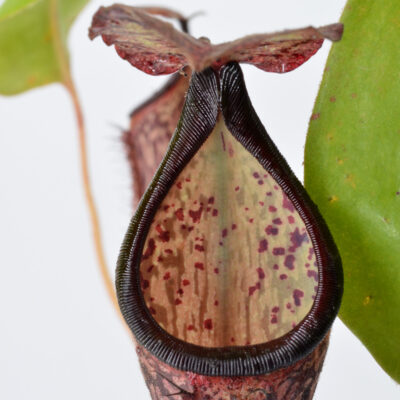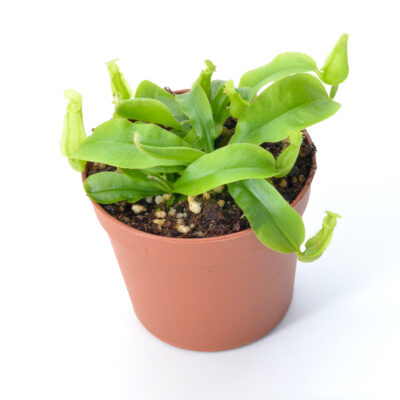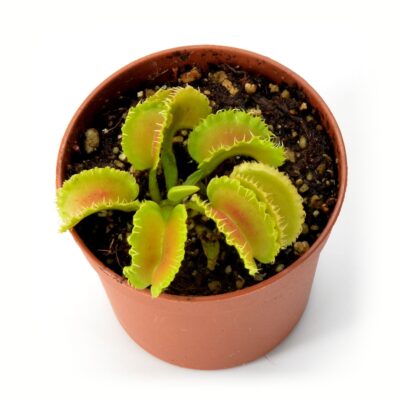Nepenthes smilesii
15.00€ *Nepenthes smilesii is a tropical pitcher plant native to northeastern Thailand, southern Laos, Cambodia, and Vietnam where it grows at altitudes between 0 and 1500 meters.
++ 30% off on all Venus flytraps with double traps – Click here
++
For beginners & collectors
Access to rare varieties
Fast shipping
Environmentally friendly
Nepenthes is a tropical carnivorous plant belonging to the genus Nepenthaceae. Generally, they find their ideal habitat among the rainforests and montane forests of the Malay Archipelago, Borneo, New Guinea, Indonesia….
Showing 1–28 of 33 results


Nepenthes smilesii is a tropical pitcher plant native to northeastern Thailand, southern Laos, Cambodia, and Vietnam where it grows at altitudes between 0 and 1500 meters.


Nepenthes x “Majin Bu” is a lowland hybrid with compact green leaves, pale red traps with streaked red/yellow peristome.


Nepenthes rafflesiana is a tropical carnivorous plant: It’s an intermediate/lowland (0-1200 m) pitcher plant from Borneo, Sumatra, Peninsular Malaysia and Singapore.


Nepenthes gracilis is a climbing-crawling plant native to Southeast Asia. It generally has reddish pitchers with dark red spots, a yellow peristome, and its leaves can reach darker shades than the pitcher.


Nepenthes x “Vamp 4”: Hybrid of Nepenthes mirabilis var. viking x Nepenthes ampullaria. Robust with striking red and yellow polka dots traps, long leaves.


Nepenthes x “Samsara” is a selection from Diflora, a clone obtained from the cross between Nepenthes (mirabilis var. globosa x boschiana) and Nepenthes (campanulata x maxima). This extremely resilient hybrid is characterized by bright green leaves and slender, elongated pitchers of bronze color with red-brown hues. The peristome is dark red.


Nepenthes kampotiana x thorelii is a nice hybrid between two lowland species, very colorful. Bronzed leaves and red ascidia. The yellow peristome makes a nice contrast with the color of the rest of the trap.


Nepenthes boschiana (after Johannes van den Bosch) is a tropical pitcher plant endemic to Borneo.


Nepenthes glabrata is a tropical pitcher plant endemic to Sulawesi. The species grows in open, high forest at elevations of 1600 to 2100 m. It produces dainty, colourful pitchers reaching only a few centimetres in height. These traps are red speckled on a yellowish background, giving them a “hand painted” appearance. The specific epithet glabrata is derived from the Latin word glaber, meaning “hairless”, and refers to the mostly glabrous nature of this species.


Nepenthes x “Big Bang” is the second seedling of the cross between Nepenthes (mirabilis “Viking” x ampullaria “Red Stripe”) and Nepenthes ampullaria ‘Black Miracle’.


Nepenthes mirabilis winged tendril x ampullaria ‘Black Miracle’ #12 is an intermediate/lowland beautiful hybrid. Round and squat traps entirely colored in pale green.


Nepenthes burbidgeae, also known as the painted pitcher plant, is a tropical plant with a patchy distribution around Mount Kinabalu and neighbouring Mount Tambuyukon in Sabah, Borneo.


Nepenthes (mirabilis “Viking” x ampullaria) x ampullaria ‘Black Miracle’ #4 in line with the genetics of the parent plants the hybrid shows a predilection to humid heat but more vigour and resistance. The traps are round and yellow with brick-red spots, mainly at the top.

Nepenthes x Hookeriana natural and common hybrid between Nepenhtes ampullaria x Nepenthes rafflesiana.


Nepenthes mirabilis winged tendril x ampullaria ‘Black Miracle’ #4 is an hybrid of 2 lowland plants, it’s more vigorous of both and more tolerant in environmental changes. Round, slightly elongated traps colored pale green.


Nepenthes mirabilis winged tendril x ampullaria ‘Black Miracle’ #8 is an hybrid of 2 lowland plants, it’s more vigorous of both.


Nepenthes lowii (N. lowii loc. Gungung Trusmadi, Borneo x N. lowii loc. Gungung Murud, Borneo) is a very rare and sought-after plant among enthusiasts due to its distinctive hourglass-shaped trap. The pitcher has this particular shape because of the mutualistic relationship it has developed with certain birds and mammals that visit its traps to feed on the nectar. These animals often leave deposits of feces near the pitchers, providing the plant with an additional source of nutrients.


Nepenthes x “Green Bomb” is a tropical lowland hybrid sown and selected in vitro by us in 2016. Green, round and stubby traps


Nepenthes x “Pink Lipstick”: Unique cross, slow initial growth, bronzed leaves. Distinctive deep bronze-green ascidium. Beautifully selected clone.


Nepenthes x “Holly” is a Lowland tropical plant resulting from the crossbreeding of Nepenthes mirabilis wing green and Nepenthes northiana.


Nepenthes x “Lucy” is the name of the hybrid between Nepenthes mirabilis wing red x Nepenthes northiana seedling number #5, selected and propagated in vitro to maintain its consistent characteristics. The trap is colored red on the outside, without ever becoming too saturated; instead, the color remains vibrant. The beauty of Lucy is that the red coloration is never uniform, always leaving space for yellow-green spots, which are denser in the lower part of the pitcher.


Nepenthes x “Clumpy Red”: Robust, lowland plant with vibrant leaves, red ascidia and striped peristome. Result of 3 years of dedicated work.


Nepenthes singalana is originating from Sumatra, it is named after Mount Singgalang, a volcano where it was first collected and described. This highland species grows between 2000 and 2800 meters but adapts well to intermediate conditions if there is at least a minimal temperature fluctuation between day and night. It is a magnificent plant with slender, bright green leaves, and large, dark, tapered pitchers with an almost black peristome that becomes very wide. On the inner side, the peristome develops a sort of “dentition,” one of the most sought-after characteristics among Nepenthes enthusiasts.


Nepenthes rafflesiana is a tropical carnivorous plant: It’s an intermediate/lowland (0-1200 m) pitcher plant from Borneo, Sumatra, Peninsular Malaysia and Singapore.


Nepenthes mirabilis winged tendril x ampullaria ‘Black Miracle’ #8 is an hybrid of 2 lowland plants, it’s more vigorous of both.


Nepenthes x “Vamp 4”: Hybrid of Nepenthes mirabilis var. viking x Nepenthes ampullaria. Robust with striking red and yellow polka dots traps, long leaves.


Nepenthes x “Majin Bu” is a lowland hybrid with compact green leaves turning bronze, red-orange traps with streaked red/yellow peristome.


Nepenthes x “Clumpy Red”: Robust, lowland plant with vibrant leaves, red ascidia and striped peristome. Result of 3 years of dedicated work.


Nepenthes rafflesiana is a tropical carnivorous plant: It’s an intermediate/lowland (0-1200 m) pitcher plant from Borneo, Sumatra, Peninsular Malaysia and Singapore.


Nepenthes (mirabilis winged tendril x mirabilis viking) x ampullaria #5 is an intermediate/lowland beautiful complex hybrid.


Nepenthes x “Majin Bu” is a lowland hybrid with compact green leaves turning bronze, red-orange traps with streaked red/yellow peristome.


Nepenthes x “Vamp 4”: Hybrid of Nepenthes mirabilis var. viking x Nepenthes ampullaria. Robust with striking red and yellow polka dots traps, long leaves.


Nepenthes x “Clumpy Red”: Robust, lowland plant with vibrant leaves, red ascidia and striped peristome. Result of 3 years of dedicated work.


Heliamphora minor, a carnivorous plant from Venezuelan Tepui, thrives in tropical highland conditions, but adapts well to most crops.


Pinguicula sp. Tolatongo: Mexican and tropical small, purplish plant with folded white-tipped lobes. Ideal for beginners. Prostrate shape.


Blonde Sphagnum Peat is the substrate par excellence, used for growing our carnivorous plants, usually mixed 50/50 with perlite.


Blond peat of sphagnum moss and perlite, mixed to 50%. The classic appropriate mix to make many carnivorous plant grow at their best, prepared by our staff.


Dionaea muscipula “Kim Il Sung”: Unique, aggressive form. Striking, distinctive appearance with irregular teeth and wavy forms. A must-have for fans!


Dionaea muscipula ‘Alien’ is a giant prostrate plant with elongated, bean-shaped, and arched traps. One of the most notable features of this cultivar’s traps is their dentition, which vaguely resembles the teeth of a monster or an alien. The “teeth” of the traps are often fused together at the base, creating a jagged and irregular appearance.


Pinguicula laueana (Crimson Flower): Tropical carnivorous plant, dark green leaves, stunning red flowers. Great for beginners.


Drosera rotundifolia is easy to grow; it has green leaves, the trap is green but if it is exposed to full sun it turns slightly red.


Agriperlite increases soil aeration for carnivorous plants. Mixed with sphagnum peat, it is an inert, expands 20 times and is microbiologically safe.


“Dionaea AR Werewolf”: upright clone with dark red color, narrow petiole, and stubby-toothed traps. Wavy and irregular. Striking yellow-orange leaf edge.
Nepenthes is a tropical, semi-climbing carnivorous plant belonging to the genus Nepenthaceae. Generally, they find their ideal habitat among the rainforests and montane forests of the Malay Archipelago, Borneo, New Guinea, Indonesia, the Philippines, and Western Australia, where they grow by using the tendril that connects the leaf to the ascidium to “cling” to the surrounding vegetation and grow taller (some can reach up to 15 meters in height). Some species can also be seen in Madagascar, Sri Lanka, and parts of India and China.
Nepenthes is a carnivorous plant that tolerates little direct sun, especially during the hottest hours of the day.
Why do they avoid direct sunlight?
Because in the wild, they live within rainforests where the sun is masked and the sunlight is filtered by taller plants.
So where should I place my Nepenthes?
For all Nepenthes, it is ideal to place them in a shady area (porch, under large trees, etc.) or by using shade cloths. If the humidity is high enough, direct sun in the early morning hours or the late afternoon hours will not be a problem.
Nepenthes poorly tolerates waterlogging, so you should keep the soil moist at all times but never soggy with water.
In summer, when temperatures are extreme, you can leave 1-2 cm of water in the saucer until it is absorbed. This is because evaporation is usually fast enough to prevent any stagnation.
Use only distilled water. Alternatively, all waters that have an extremely low mineral salt content are suitable. For example, all condensation water (air conditioner, dehumidifier) conductivity of the water should have a value of fewer than 50 microsiemens.
Why should stagnant water be avoided?
In their habitat, the soil is very draining, so water percolates downward. For this reason, it is extremely rare for there to be water stagnation.
In response, stagnation would cause a lack of oxygen in the soil; this condition results in root asphyxia, and as a result, the delicate roots of Nepenthes would rot irreparably.
Why use distilled water?
There are several reasons, but let’s try to think in terms of the environment.
What does it mean to grow Nepenthes in an extremely rainy environment on draining soil of a mostly inert nature?
Simply put, the mineral salts and most of the nutrients in the soil are constantly washed away by rain, which by its nature does not contain minerals. For this simple reason, the root system of Nepenthes has adapted to receive very few nutrients from the soil.
An essential point for good results is to ensure high air humidity because, as mentioned above, Nepenthes grows in rain-fed environments where rain is very frequent and, therefore, humidity is very high.
A lack of humidity would damage the leaves irreparably.
However, good air recirculation is required to avoid fungal diseases that may arise in high-humidity situations.
How can I solve this problem?
Let’s not panic because there are many solutions! Let’s start with the assumption that many of the easiest Nepenthes to grow make do with a generous sprinkling of distilled water 2-3 times a day all over the plant. If you decide to grow indoors, such as in a semi-enclosed terrarium, the problem is practically solved from the start because the relative humidity of the air inside a terrarium is sufficient, though it is still a good idea to spray the leaves frequently.
Alternatively, many growers use misting or fogging systems (i.e., recreating fog with more or less inexpensive tools), especially inside large terrariums, grow rooms, or greenhouses.
The use of misting systems is very useful when growing highland Nepenthes because these systems help to bring down temperatures, avoiding too high temperatures during the day and at dusk by also helping to create the necessary temperature change. (Note: these systems alone help but do not guarantee ideal conditions; for best results, fans, extractors, water cooling systems, air conditioners, etc. are usually used.)
While 50% peat and 50% perlite is fine as a general substrate, and consequently even for Nepenthes it creates no problems, many growers use mixtures in various proportions of peat, perlite, bark, akadama, and dry or live sphagnum.
In my experience, a mixture of 60 percent perlite and 40 percent peat, with the addition of live or rehydrated sphagnum moss to wrap the roots and give a little extra moisture, turns out to be a good compromise for beginners struggling to find certain materials.
Personally, I have had the best results by mixing rehydrated dry sphagnum moss and perlite in equal proportions and always adding live sphagnum moss around the base of the plant.
CAUTION: Do not breathe in unprotected perlite dust; moisturize it properly before handling it; it is very fine dust and harmful to our lungs!
Why such light soils?
Because Nepenthes needs moisture, it also needs very aerated soils to avoid root rot problems. Consequently, it is good that the soil does not have too much peat or material that can “pack down.” It is therefore preferable to increase the proportion of perlite or possibly add other materials that are always inert with a thick and suitable grain size so that the roots can “pack up” while still remaining well aerated. In addition, it is essential that the substrate be free of nutrients, as in the long run, they would be detrimental to Nepenthes, which, although more tolerant than other carnivorous plants, may no longer develop ascidia and in the long run would inexorably lead to the death of the plant.
Can I fertilize my Nepenthes?
It is always a good idea to avoid fertilizing all carnivorous plants, including Nepenthes.
However, it is possible from time to time to fertilize Nepenthes (this genus of the carnivorous plant only) with very dilute doses of orchid fertilizer or any generic foliar nutrient, as long as you follow three rules:
Nepenthes do not go into dormancy! Because they are tropical plants, they can vegetate all year, but only under constant conditions.
Solutions to ensure more or less constant conditions all year round are different depending on the type of habitat they belong to, i.e., whether Nepenthes is lowland, intermediate, or highland.
To solve this problem, it is necessary to ensure dry soil and relatively low air humidity.
Let us try to clarify this in more detail.
If you decide to make the indoor-outdoor move, i.e., grow Nepenthes outside in summer and inside in winter, it is important to move the plants at the time most suitable for them. That is, when outdoor temperatures (especially night temperatures) are balanced with indoor temperatures so as to avoid overstressing the plant.
For beginners and collectors
Access to rare and unusual varieties
Sustainable & environmentally friendly
Fast and secure international shipping
Stay up-to-date with the latest news and offers from Diflora! By subscribing to our newsletter, you’ll be the first to know about new arrivals, exclusive promotions, and expert tips on how to care for your plants.
No products in the cart.
Recently viewed products: